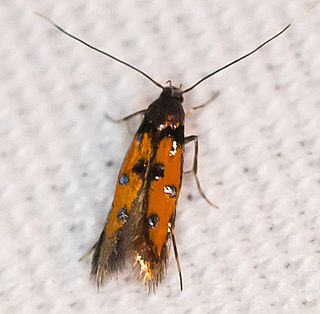
The Agonoxeninae are a subfamily of moths.

The Elachistidae are a family of small moths in the superfamily Gelechioidea. Some authors lump about 3,300 species in eight subfamilies here, but this arrangement almost certainly results in a massively paraphyletic and completely unnatural assemblage, united merely by symplesiomorphies retained from the first gelechioid moths.

Chrysoclista linneella, is a moth of the family Agonoxenidae found in Europe and North America.

Pancalia leuwenhoekella is a moth in the family Cosmopterigidae.

Spuleria is a genus of moths of the family Elachistidae. It contains only one species Spuleria flavicaput, which is found in most of Europe and Anatolia.
Chrysoclista is a genus of moths of the family Agonoxenidae described by Henry Tibbats Stainton in 1854.
Chrysoclista cambiella is a species of moth of the family Agonoxenidae. It is found in the United States and Canada.
Chrysoclista villella is a species of moth of the family Agonoxenidae. It is found in the United States (Washington) and Canada.

Chrysoclista lathamella is a species of moth of the family Agonoxenidae described by Thomas Bainbrigge Fletcher in 1936. It is found in northern Europe.
Chrysoclista splendida is a species of moth of the family Agonoxenidae. It is found in Portugal, France, Germany, Poland, Slovakia, the Czech Republic, Austria, Hungary, Romania, Bulgaria and North Macedonia. There are also records from Sweden.
Dystebenna is a genus of moths of the family Elachistidae. The genus is mostly placed in the family Elachistidae, but other authors list it as a member of the family Agonoxenidae. It contains only one species Dystebenna stephensi, which is found in Asia and Europe.
Haplochrois theae is a species of moth of the family Elachistidae. It is found from western Transcaucasia and Anatolia to China. It probably originated from Southeast Asia. During the 20th century, this species was a serious pest on tea plantations in Georgia and to a lesser degree, in the Krasnodar Territory of Russia.
Chrysoclista zagulajevi is a species of moth of the family Agonoxenidae. It is found in Georgia and Adjara (Transcaucasia).
Chrysoclista abchasica is a species of moth of the family Agonoxenidae. It is found in the Czech Republic, Georgia and Abkhazia (Transcaucasia).
Anatrachyntis coridophaga is a moth in the family Cosmopterigidae. It is found in Egypt and Libya.
Chrysoclista basiflavella is a moth of the family Agonoxenidae. It was described by Shōnen Matsumura in 1931. It is found in Japan.
Chrysoclista hygrophilella is a moth of the family Agonoxenidae. It was described by Viette in 1957. It is found on Réunion.
Chrysoclista monotyla is a moth of the family Agonoxenidae. It was described by Edward Meyrick in 1921. It is found in Australia (Queensland).
Chrysoclista thrypsiphila is a moth of the family Agonoxenidae. It was described by Edward Meyrick in 1912. It is found in Sri Lanka.
Chrysoclista trilychna is a moth of the family Agonoxenidae. It was described by Edward Meyrick in 1928. It is found in India (Madras).






